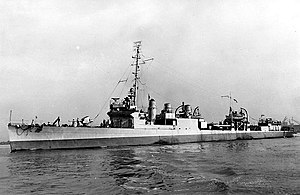USS Blakeley (DD-150)

USS Blakeley in September 1942, after modernization
|
|
| History | |
|---|---|
|
|
|
| Namesake: | Johnston Blakeley |
| Builder: | William Cramp and Sons |
| Cost: | $1,448,367.50 (hull & machinery) |
| Laid down: | 26 March 1918 |
| Launched: | 19 September 1918 |
| Commissioned: | 8 May 1919 |
| Decommissioned: | 21 July 1945 |
| Struck: | 13 August 1945 |
| Fate: | Sold for scrapping, 30 November 1945 |
| General characteristics | |
| Class and type: | Wickes-class destroyer |
| Displacement: | 1,154 tons |
| Length: | 314 ft 5 in (95.83 m) |
| Beam: | 31 ft 8 in (9.65 m) |
| Draft: | 9 ft (2.74 m) |
| Speed: | 35 knots (65 km/h) |
| Complement: | 122 officers and enlisted |
| Armament: |
|
The second USS Blakeley (DD–150) was a Wickes-class destroyer in the United States Navy, named for Captain Johnston Blakeley.
Built in 1918, she saw patrol duty along the East Coast of the United States during the interwar era. Decommissioned for several years, she returned to duty at the outset of World War II. She spent much of the war on convoy patrol duty in the Caribbean. On 25 May 1942, while on patrol, she was struck by a torpedo fired by German submarine U-156, which blew off her forward 60 feet (18 m). Fitted with temporary measures, she steamed to Philadelphia Naval Yard where she was fitted with the forward section of sister ship USS Taylor. She spent much of the rest of the war on convoy patrol duty before being sold for scrap in 1945.
Blakely was one of 111 Wickes-class destroyers built by the United States Navy between 1917 and 1919. She, along with 20 of her sisters, were constructed at William Cramp and Sons shipyards in Philadelphia using specifications and detail designs drawn up by Bath Iron Works.
She had a standard displacement of 1,154 tonnes (1,136 long tons; 1,272 short tons) an overall length of 314 feet 5 inches (95.83 m), a beam of 31 feet 8 inches (9.65 m) and a draught of 9 feet (2.7 m). On trials, Blakeley reached a speed of 35 knots (65 km/h; 40 mph). She was armed with four 4"/50 caliber guns, two 3"/23 caliber gun, and twelve 21-inch torpedo tubes. She had a regular crew complement of 122 officers and enlisted men. She was driven by two Curtis steam turbines powered by four Yarrow boilers.
...
Wikipedia
